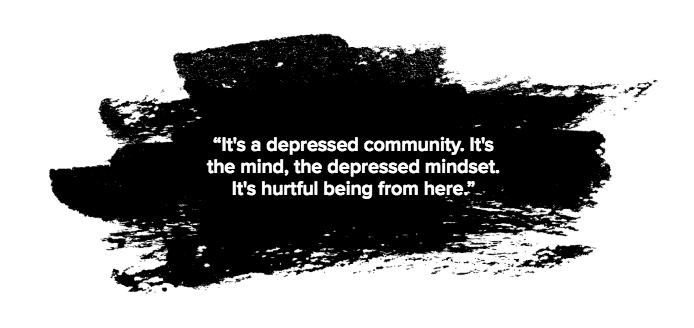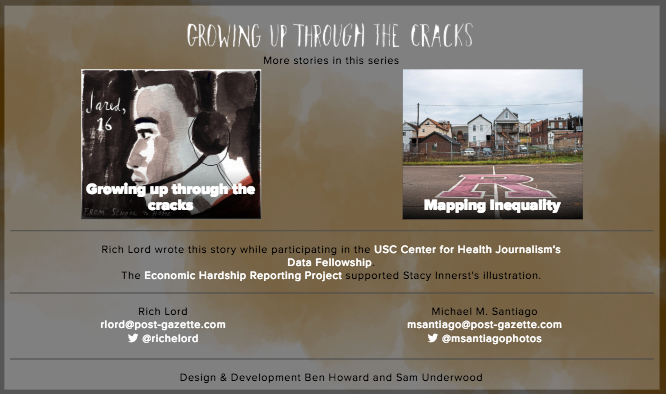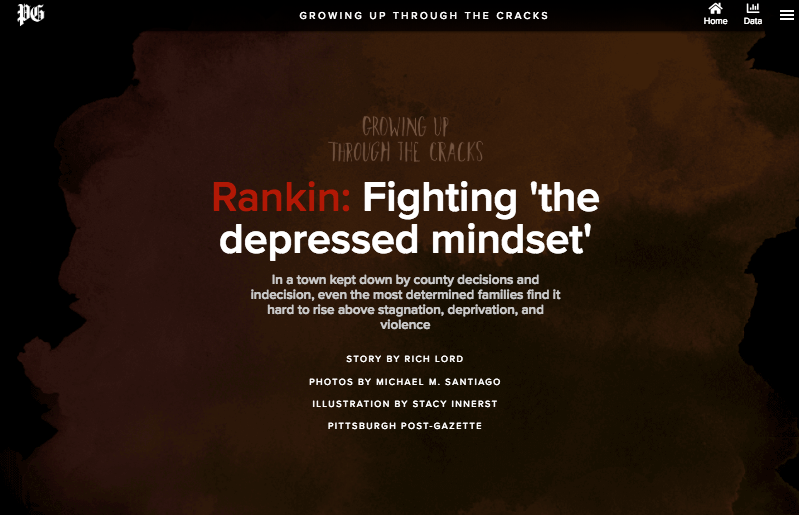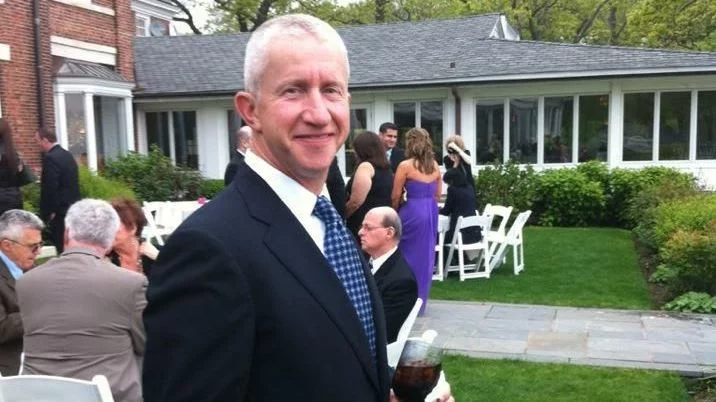How The Pittsburgh Post-Gazette reported stories of ‘growing up through the cracks’
From July to December 2018, Pittsburgh Post-Gazette journalist Rich Lord found himself in an increasingly uncommon position for reporters at non-national publications: He had six months to report an enterprise story on the ground in a local community, and had a photographer and illustrator assigned to work with him at every step of the way.
In a Jan. 14 article titled “Rankin: Fighting ‘the depressed mindset,’” Lord chronicled a trio of families in the Pittsburgh-adjacent, financially distressed former mill town through countless hours of reporting and vivid images and drawings. The story is part of a series called “Growing up through the cracks,” which spotlights communities in Western Pennsylvania in which at least half of the children are in poverty.
In a Q&A, Lord detailed how he was able to devote such resources to one story in an industry strapped for resources, and gave insight into the long reporting and writing process itself. Here’s that conversation, minimally edited for conciseness.
How did you get a position that allowed you to do such a long, in-depth story?
I started out here as the city government reporter, covering day-to-day city news out of council and the mayor’s office, and other city-related offices. I did that until 2010, then became the federal courts reporter from 2010-2014. From 2014 on I have been primarily a projects reporter doing longer-term involved series and stories.
When I was covering beats I always tried to find time to do enterprise reporting, longer term stories. At the end of my city hall tenure in 2010, I proposed a project on the people who were pulling the strings on politics in our region, including our city and county government. I spent six months doing a project that stemmed from the city hall work, and I kept doing projects during my tenure in federal courts between daily stories. It wasn’t an abrupt transition. When we decided to create a projects group I was asked to join, and happily did that.
Has the Post-Gazette been committed to such long projects for a long time?
The PG has a history of being very comfortable with projects. Before I got here there were huge projects, and since I’ve been here there were huge projects. And periodically the PG creates special project groups, investigative teams. Right now our model is a little different. We built ad hoc teams around projects and often people might spend a third or half of their time on projects until it ripens and you spend a lot of time doing just that to get it ready for publication. It’s always been a publication that’s open to projects and travel and letting reporters spend meaningful time on longer-term stories. Even though we don’t have the staffing we used to have, there’s still an understanding that good journalism takes time.
How did you identify child poverty as the connecting thread for this series?
In late 2017 I was trying to think of ways to align our resources with the needs of our community. I had a conversation with a demographer at one of the local universities and said ‘what are the metrics that would show us, frankly, which communities need attention, need coverage, need resources.’ And that demographer said ‘Why don’t you look at child poverty?’ It’s a stat that not only captures distress, but it also does it in a way that tends to evoke a certain level of sympathy and human understanding.
Starting in late 2017 I was analyzing the data and seeing where the problem was, where we had the highest levels of child poverty. By mid-2018, we decided our approach, we had picked our dozen communities we wanted to look at. July 2, 2018 was my first day spending time in Rankin. Other members of the team have been in others of the 12 communities. That’s the genesis of it.
I didn’t log the hours, but I would try to be in Rankin for parts of two days every week. Often that would skew from the early afternoon into 8 or 9 o’clock depending on who was available for interviews. As you saw from the story, almost everybody we interviewed is working, so a lot of times we had to spend time with them at night. I would say I spent most of two days per week in Rankin for most of the last half of 2018.

How did you familiarize yourself with the community?
I wasn’t totally unfamiliar with the community. I had done occasional stories there before. My first stop was the Rankin Christian Center. They weren’t a major part of the story but they got me some introductions to people. Then I hung out at the city council meeting. I went to almost all of the borough council meetings during that six months, because people come together at those meetings. Then I built from there. I reached out to church leaders. There aren’t that many institutions there, though I think I stopped into every independent business in Rankin, though you could count that on one hand. And then you just start to see people repeatedly.
James Weems, as you know, was a central figure in the story. I first saw him at the city council meeting and I said ‘Oh okay, he’s okay, I don’t really want to talk to him right now though.’ Then I ran into him a couple days later at a business, and then I ran into him a couple days later hanging out in front of his house with his kids. At that point I’m like, okay I’ve run into this guy three times, he seems to be doing some interesting things. He’s an energetic guy. I’m going to develop this relationship. Three families became the focus of the story. I don’t remember committing to any family immediately. And there were probably a dozen families with which we had communicated, spent some time, but did not end up being part of the story. You have to make choices.
How did you weave together so many scenes, people and anecdotes?
I started writing chunks, as I call them, pretty early because I realized I was at risk of forgetting everything I learned early on. Any time I would come back from something interesting, or a trend had occurred to me, or I uncovered a piece of Rankin history, I would write a chunk. And then eventually I had many, many pages of chunks. They weren’t notes, they were groups of a few paragraphs. When I had my chunks, eventually the structure came into the view, and I decided that the Weems family would be the centerpiece of the story because they brought together a lot of the issues and they were a good thing to build around. The Todds and the Kings were another part of the story. It was a matter of dealing with the chunks and dealing with the transitions. But I started writing long before I knew what the structure. There was ridiculous amounts of shifting things around. The top of the story that I originally drafted was completely changed.
How involved were the visual content producers in your reporting?
The photographer, Michael Santiago, was with me very early in the game. There were many interviews in which Michael participated in the questioning and didn’t take a picture. By the end his time commitment was equal to or exceeded mine. Even when the writing was done he kept going back to get stronger and stronger images. Visuals was not an afterthought. Visuals was right in the center of every part of the effort. He and I collaborated to choose the images that appeared. We also had the unusual involvement of an illustrator. We brought him in a little later in the game, and introduced him to the people we were working with.
Do you think this heavy investment in the visual side of a story is a good one for the paper?
We have visual rich packages we’ve done in recent years on the opioid epidemic and historic events. We do believe in it. In this case, the illustration was an unusual wrinkle for us, but we thought it would be the kind of thing that would set it apart. There’s a risk when you write about child poverty when people could look at the top of the story and say ‘Oh, poor kids, it’s going to be sad, I’ve read this before, I’m not going to read it again.’ But if you throw in the drawn depiction of Jared Todd’s life, or if you throw in the opening frame interactive with the drawn portrait that turns into a photo, or if you lead a child poverty story with a family that isn’t in poverty, we hope that people will say ‘Huh, I haven’t seen that before.’

- How The Pittsburgh Post-Gazette reported stories of ‘growing up through the cracks’ - February 19, 2019
- The Athletic hopes to solve sports reporting with fewer ads and deeper stories - December 19, 2017





